Bedbugs are a fact of urban, and these days, even suburban life, and a growing problem for residents in communal environments. As the bedbug epidemic mushrooms, the likelihood of having bedbug encounters grows significantly each year.
Co-ops, condos and HOAs are not immune, no matter the neighborhood or the municipality. Before World War II, an estimated 30 to 40 percent of buildings in the greater New York City area had bedbug issues, and the current bedbug epidemic looks like it will reach that level.
Management companies and boards do not have a lot of time to discuss how to handle bedbug issues once these insects are reported or suspected of taking up residence. Having a protocol in place for dealing with bedbugs is vital to ensure a prompt and effective response. Providing residents a protocol, as well as educational material, shows them how seriously the issue is being taken.
A proper protocol includes proactive and reactive components such as prevention, early detection, response times, pre-treatment preparation, remediation strategies, and budgeting.
Prevention and early detection protocols include educating residents about bedbugs and their signs and inspections by bedbug detection dogs.
Impeding and eliminating bedbug infestations involve complex and cooperative processes that require residents’ vigilance and assistance. The building’s protocol should:
• Educate residents on best practices to avoid bringing these pests into the building.
• Encourage residents to report bedbug activity.
• De-stigmatize the issue as bedbugs are not related to socioeconomic status or cleanliness.
• Explain that the elimination process is extended, detailed, and demanding: the preparations are significant; multiple treatments two weeks apart are required; and the period in between pest control services is highly inconvenient.
A bedbug protocol should detail that managing agents and boards will:
• Keep records of complaints and make efforts to track the source of an infestation.
• Institute a building-wide prevention program that includes the avoidance of unnecessary risks such as purchases of used furniture, and the removal of furniture from an infested unit without proper precautions.
Constantly watch for this problem.
Commit to ongoing communications with residents and staff.
Inspections
Because finding bedbugs is so difficult, having a protocol in place is that much more important. The search for a bedbug is analogous to trying to find a moving needle in a haystack. A newly hatched bedbug is 1mm in size (the size of the tip of a ball point pen) and translucent. The eggs are also 1mm in size and have a pearly translucent appearance. A non-engorged bedbug is as thin as a fingernail. A bedbug can grow to be 5mm, the size of an apple seed. The bedbugs’ small size enables them to hide deep in cracks and crevices, on any item.
Any co-op or condo protocol should address inspections, how they are to be performed and their frequency. It should address proactive inspections as well as rules for inspections when bedbugs are found or suspected. A protocol details if neighboring units are to be inspected if bedbugs are found in one unit. The goal is to have as few surprises as possible about the process.
Protocols should address if, when and how to use bedbug-sniffing canines. Although there is no tool that is 100 percent accurate at finding low level infestations of bedbugs, trained detection dogs are the most accurate tool available. Dogs were proven to be 95 to 98 percent accurate in university studies, where a trained person is at best 40 percent effective at finding bedbugs when there are low-level infestations.
Trained bedbug dogs are the tool of choice to determine if bedbugs are present when a board or managing agent wants to determine if there are undetected problems in a building. Canine inspections can prove cost effective by locating bedbugs before they become overwhelming infestations, potentially reducing the total treatment area of the building, and in turn lowering the cost.
There are no steadfast rules for the frequency or breadth of preventative canine inspections. Each board and/or property manager needs to determine how proactive it wants to be.
When Bedbugs Are Reported
Any building’s bedbug protocol should spell out how quickly building management and affected residents need to respond to bedbug reports with inspections and treatments. A bedbug infestation is analogous to a leaky pipe, which, if not fixed, can quickly damage other nearby units. Solving a large infestation is significantly more expensive and difficult than a limited one.
The protocol should also address:
The methodology for bedbug remediation. The treatment method should be consistent throughout the building. Labor-intensive physical solutions such as freezing (vs. chemicals) are recommended to solve issues. bedbugs are resistant, if not immune to most pesticides; at least a small portion of unit owners will take issue with chemical treatment for health reasons.
That getting complete treatments to solve problems are not negotiable. Piecemeal solutions such as furniture disposal of an affected mattress or piece of furniture are not acceptable substitutes.
That the resident must cooperate by preparing the home. A unit that is not packed and cleaned in advance significantly decreases the efficacy of the bedbug treatment.
That multiple treatments are necessary due to the biology of these insects.
Having well-considered policies, in the form of a protocol is smart building management and vital to combatting the accelerating bedbug epidemic.
Jennifer Erdogan is the director of the bedbug division of Bell Environmental Services, based in Parsippany, New Jersey, and servicing the greater metro New York area




Leave a Comment